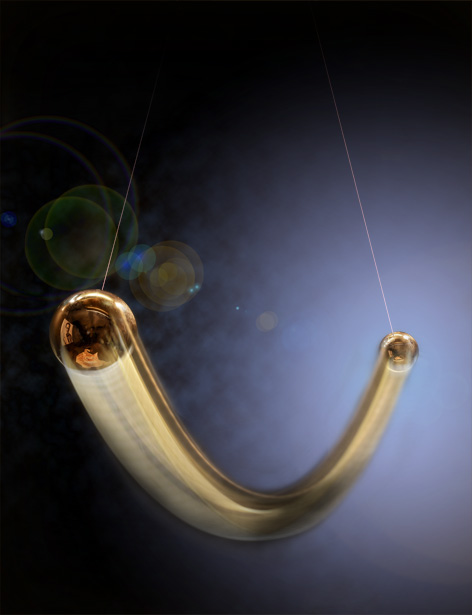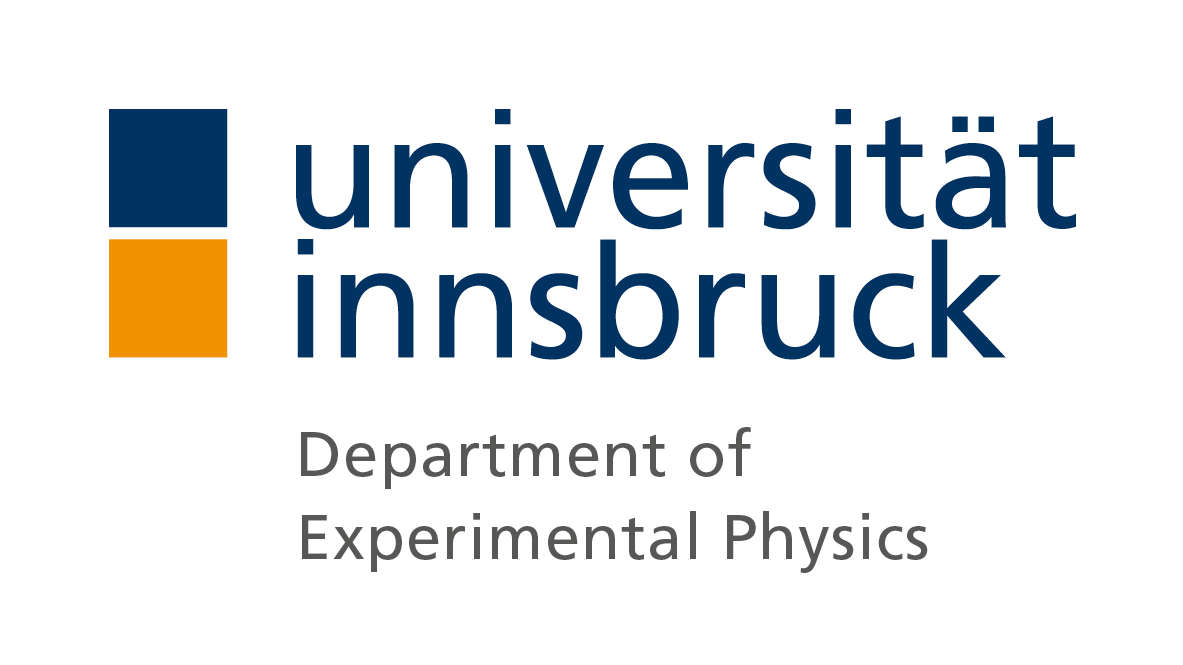Entanglement-enhanced detection of single-photon scattering events
C. Hempel, B. P. Lanyon, P. Jurcevic, R. Gerritsma, R. Blatt, C. F. Roos.
Nature Photonics 7, 630 (2013)
arXiv version: PDF
Spectroscopy is used in a wide range of scientific fields to gain information about the internal structure of atoms and molecules. From radio waves to x-rays, the whole electromagnetic spectrum can be used to infer fundamental properties of matter from spectroscopic data. Timekeeping is based on spectroscopy as well. The current definition of the second is based on the resonant interaction of a microwave field with cesium atoms in a fountain clock. Using a method known as Ramsey spectroscopy the microwave frequency is kept in synchrony with the natural transition frequency given by the energy difference between two internal electronic states within the atoms.
Quantum logic spectroscopy
Optical frequency standards superior to cesium fountain clocks have been developed using light waves instead of microwaves. One approach to such an optical atomic clock uses a single trapped ion as reference. Here, in a technique called quantum logic spectroscopy [1], advances in the fields of ion trapping and quantum information were combined in order to probe a narrow transition in 27Al+ (the "spectroscopy ion") while performing the detection on an auxiliary, co-trapped "logic ion". As direct laser cooling of aluminum is not feasible, the auxiliary ion is also used to sympathetically cool [2] the spectroscopy ion via the strong Coulomb interaction between the charged particles.
A key requirement for the spectroscopic technique to work is the ability to spectrally resolve motional sidebands. These are additional resonances around the transition in question resulting from the Doppler shift caused by the ion's motion in the trap. Given typical motional frequencies in the range of one to a few MHz, this requirement limits the kind of transitions that can be investigated. What is not a problem for a frequency standard, prevents the use of the technique in the investigation of broad transitions in other atomic or, more complex, molecular ions.
 Figure 1 - Quantum pendulum
Figure 1 - Quantum pendulum
A motional Schrödinger cat state of an ion crystal consists of two parts that oscillate with opposite phase in the trapping potential - much like a classical pendulum that swings in two opposite directions at once. (Image credit: IQOQI / Knabl)
Furthermore, in the investigation of optical spectra in atomic and molecular ions the line-width of a transition is not the only concern. There are cases in which absorption or emission processes in scattering events are limited to only a few or even just one photon. The reasons for that can be of technical nature - e.g. due to issues in producing or delivering the light needed for spectroscopy - or simply result from the fact that a transition is not closed. In such an open transition the electronic state does not decay back to its original state, thus preventing repeated scattering events on the same transition (figure 2.b).
We address both problems by implementing a variation of a Ramsey experiment (figure 3) in a setting analog to quantum logic spectroscopy. Using a non-classical state of motion, the method presented in the following enables both, high sensitivity at the single-photon level as well as access to broad transitions.
Detecting the photon recoil
Instead of trying to detect the scattered photons themselves, we measure the momentum kick imparted on the ion in such a process. By the law of momentum conservation the ion recoils by an amount that is proportional to the energy of the absorbed and emitted photon. In typical situations, with the ion initially brought to the motional ground state of its trapping potential, the displacement caused by a photon in the visible range of the spectrum will excite the ion's motion only in about one out of 100 scattering events.
 To increase the chance of detection, we prepare a very sensitive quantum mechanical state before the scattering event takes place. Its susceptibility to disturbances from the environment (decoherence), e.g. from a momentum kick of a scattered photon, is usually an unwanted effect in quantum optics experiments. In our case, it allows us to boost the detection efficiency from 1.6% to 12%. With an optimized experimental setup this number could even be pushed up to 60%.
To increase the chance of detection, we prepare a very sensitive quantum mechanical state before the scattering event takes place. Its susceptibility to disturbances from the environment (decoherence), e.g. from a momentum kick of a scattered photon, is usually an unwanted effect in quantum optics experiments. In our case, it allows us to boost the detection efficiency from 1.6% to 12%. With an optimized experimental setup this number could even be pushed up to 60%.
Figure 2
a) Harmonic potential provided by the Paul trap. Indicated is the discrete ladder structure of motional energies with both ions occupying the ground state.
b) Reduced level structure of 44Ca+. The meta-stable D3/2 state can couple to the P1/2 state via an electronic dipole transition with an energy equivalent to an infrared photon of 866 nm wavelength. The P1/2 decays back to the S1/2 ground state under emission of a blue photon of 397 nm wavelength.
In our experimental demonstration we confine ions of two calcium isotopes in a linear Paul trap. Laser cooling and detection are provided by 40Ca+, our logic ion, while we perform spectroscopy on a co-trapped 44Ca+ ion.
After cooling the two-ion crystal to the ground state of its center of mass vibrational mode, we prepare the 44Ca+ ion in its metastable D3/2 state (figure 2.b). This preparation ensures that, if a photon is scattered on its D3/2 → P1/2 transition, the electronic state of the spectroscopy ion decays back to the S1/2 ground state with 93.6% probability. Consequently, to scatter more than one photon per experiment becomes unlikely.
Cat state spectroscopy
Now the spectroscopy sequence (figure 3) starts by first creating a motional Schrödinger cat state [3]. In such a state the internal electronic state of the logic ion becomes entangled with the external motion of the two ions in the trap. If now, in the second step, a photon is scattered on the spectroscopy ion, the motional parts of the cat state become displaced in phase space. In a final step, the creation of the Schrödinger cat state is reversed, disentangling the motion from the internal state of the logic ion.
 Figure 3 - Spectroscopy sequence in time and phase space (a) Laser pulses tailored to the logic ion (orange) create and recombine a Schrödinger cat state, while in between spectroscopy light of a different frequency causes a photon to be scattered off the spectroscopy ion (blue).
Figure 3 - Spectroscopy sequence in time and phase space (a) Laser pulses tailored to the logic ion (orange) create and recombine a Schrödinger cat state, while in between spectroscopy light of a different frequency causes a photon to be scattered off the spectroscopy ion (blue).
(b) The quantum mechanical wave packet of a ground-state cooled two ion crystal is represented as a circle in phase space, with Its minimal diameter given by Heisenberg's uncertainty principle in position (x) and momentum (p). The enclosed area corresponds to a geometric phase Φ that is accumulated with opposite sign by both parts of the wave packet.The geometric phase [4] acquired in the scattering process remains encoded in the logic ion's internal state. Using the well established and very efficient detection technique known as electron shelving, we can then directly measure it and infer that a scattering event took place.
The geometric phase [4] acquired in the scattering process remains encoded in the logic ion's internal state. Using the well established and very efficient detection technique known as electron shelving, we can then directly measure it and infer that a scattering event took place.
Figure 4 shows the result of our application of the cat state spectroscopy method in the investigation of the D3/2 → P1/2 open dipole transition in 44Ca+.

Figure 4 - Spectroscopy result.
Line profile of the D3/2 to P1/2 open dipole transition reconstructed from single-photon scattering events.
Aside from the immediate application in the spectroscopy of atomic and molecular ions, we also see potential use for the technique in quantum information processing. In protocols establishing remote entanglement between quantum computational nodes (e.g. based on trapped ions) it is crucial to avoid obtaining any information about the photons used to establish the remote entanglement. As our indirect detection scheme does not gain information about the specific quantum state of the photon or the ion before and after scattering, it could provide a useful indicator that such an entangling event took place without degrading it in the process.
Literature
[1] Schmidt, P.O. et al. Spectroscopy using quantum logic. Science 309, 749-752 (2005). (PDF)
[2] Larson, D.J., Bergquist, J.C., Bollinger, J.J., Itano, W.M. & Wineland, D.J. Sympathetic cooling of trapped ions: A laser-cooled two-species nonneutral ion plasma. Phys. Rev. Lett. 57, 70-73(1986). (PDF)
[3] Monroe, C.R., Meekhof, D.M., King, B.E. & Wineland, D.J. A 'Schrödinger cat' superposition state of an atom. Science 272, 1131-1136 (1996). (PDF)
[4] Chaturvedi, S., Sriram, M.S. & Srinivasan, V. Berry’s phase for coherent states. J. Phys. A: Math. Gen. 20, L1071–L1075 (1987).
Financial support
This research was supported by the Austrian Academy of Science, the University of Innsbruck, and by the European Commission via the integrated project Atomic QUantum TEchnologies and a Marie Curie International Incoming Fellowship.

